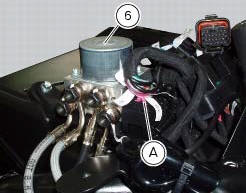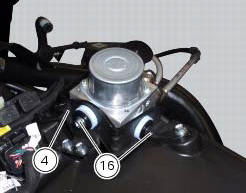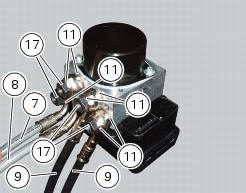
Ducati Diavel Service Manual: Removing of the abs control unit

Drain the hydraulic fluid that is inside the front and rear braking system tubes by disconnecting them from the master cylinder and the calliper (sect. 4 -3, Changing the brake fluid).
Disconnect the connector (a) of the abs control unit (6).

Loosen the screws (16) that retain the abs control unit support (12) and remove it from the vehicle.

Undo the four special screw (17) fixing the pipes (10), (9), (8) and (7), on the abs control unit (6), removing the gaskets (11).
Warning
Every time that gaskets (11) are removed, they must be replaced with new gaskets (11).

Important
Do not open the abs control unit: if it is faulty, replace it.
Note
If it is necessary to replace one or more pipes, follow the instructions indicated in paragraph "flexible wiring/hoses positioning" of this section.
 Replacing the rear phonic wheel sensor
Replacing the rear phonic wheel sensor
Disconnect the rear abs sensor (5) connector (c) from the main electric
wiring.
Open all the retainer clamps of the rear abs sensor cable (5): refer to table of
sect. 7 - 6, Flexible wiring ...
 Refitting the abs control unit
Refitting the abs control unit
If the brake hoses (7), (8), (9) and (10) on the abs control unit are changed
or removed, ensure that the fittings on the
control unit are positioned correctly.
Warning
If incorrectly positioned, ...
Other materials:
Overhauling the rear swingarm
Inside the swingarm (8), in correspondence with the pivot point on the frame,
there is a pair of ball bearings (10) and a
spacer (11) on the rh side, and a pair of roller bearings (6), with sealing
rings (5), on the lh side.
To change the bearings, proceed as follows.
Remove the shims ( ...
Alternator
It is equipped with a 12 v, 430 w generator, consisting of a fixed element
(stator, a) located on the generator cover and
of a movable element (rotor, b) fixed to the crankshaft.
Note
To check the battery charging system for faults, use the dds diagnosis
instrument and follow the instruct ...
Running-in recommendations
Maximum rpm (fig. 114)
Rotation speed for running-in period and during standard use
(rpm)
Up to 1000 km;
From 1000 to 2500 km.
Up to 1000 km
During the first 1000 km, keep an eye on the rev counter.
It should never exceed
5500÷6000 rpm.
During the first hours of riding, it ...